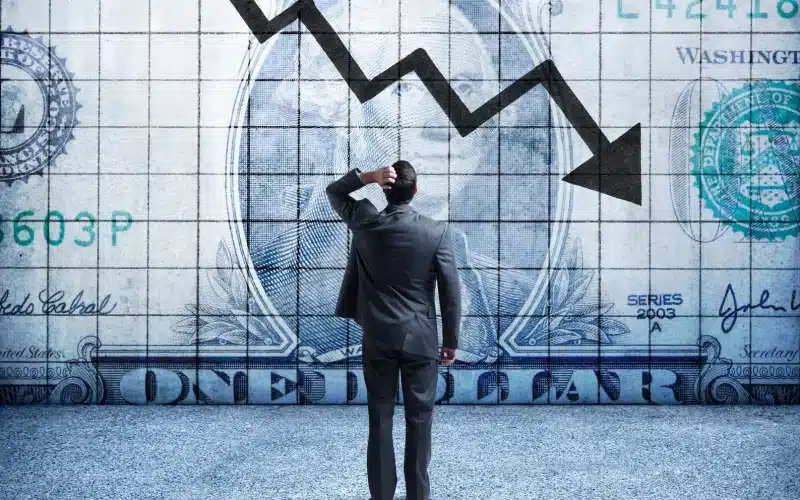Several economic indicators are pointing in different directions, and with each new data release, a fresh round of headlines stating that the likelihood of a recession has increased or decreased is released. In this article, we are going to be discussing what a recession is, signs that indicate if we are headed for a recession, and its causes.
What is a Recession
A significant, pervasive, and protracted decline in economic activity is referred to as a recession. Although more complicated calculations are often utilized, a general rule of thumb is that two consecutive quarters of negative gross domestic product (GDP) growth indicate a recession.
In addition to other indicators, economists at the National Bureau of Economic Research (NBER) examine at nonfarm payrolls, industrial production, and retail sales, going much beyond the more basic (although less precise) two-quarters of negative GDP measure.
Recognizing Recessions
Although recessions are still frequent, most economies have expanded consistently since the Industrial Revolution with few exceptions. According to the International Monetary Fund, there were 122 recessions between 1960 and 2007 nearly 10% of the time affecting 21 advanced economies (IMF).
Recession-related decreases in economic output and employment may spiral out of control. For example, diminishing consumer demand might drive companies to lay off personnel, which reduces consumer purchasing power, and can further undermine consumer demand.
Why do Recessions Happen?
To understand why and how an economy enters a recession, many economic theories have been proposed. These theories can be broadly divided into three categories: financial, psychological, and/or economic.
Some economists place the most importance on economic changes, including structural changes in industries. For instance, an abrupt, prolonged increase in oil prices can drive up prices throughout the economy, triggering a recession.
Are we Headed for a Recession?
With the following details, it’ll be certain to know whether or not a country is headed for a recession.
#1. Economic Information
- Domestic product, or GDP (GDP)
- Latest Report: Q4 GDP +2.9% (advance reading)
- Grade: Good
According to the second estimate of the U.S. GDP, the economy expanded at an annualized pace of 2.9% in the last quarter of 2022. This came after a third-quarter GDP annualized growth rate of 3.2%, which contributed to yearly GDP growth of 2.1% overall. Evidently, these figures pull the United States further away from the brink of a recession is defined as two consecutive quarters of negative GDP growth.
Bill Adams, the chief economist at Comerica Bank, stated that “the economy developed decently in 2022, and the fears of a recession started in the first half of last year were unwarranted.” Adams continued, “But the picture is different looking forward.”
According to Adams, additional data points, including jobless claims, factory surveys, and the yield curve, suggest that the U.S. may be fast moving toward the recession that we have been avoiding for the better part of a year.
#2. Index of Consumer Prices (CPI)
- Most recent Report: CPI +6.5% in December
- Grade: Bad
Since reaching a peak of 9.1% in June, inflation has slowed. The CPI number for December, which was 6.5% compared to November’s 7.1%, was lower. Even said, inflation is still far higher than the Fed’s target range of 2% to 3%, which is having a significant impact on the typical American’s purchasing power.
#3. Industrial Production Index
- Latest recent report: ISM Manufacturing 48.4 for December
- Grade: Bad
This study of corporate executives from industrial enterprises had, until recently, produced good results every month for more than two years. But despite more than two years of growth, the ISM manufacturing index actually decreased in December for the second consecutive month due to weaker demand and sluggish output.
The purchasing managers index (PMI) is a poll of purchasing and supply executives in more than 400 industrial enterprises across the U.S. Not all signs were considered bad by this month’s respondents. Although consumer demand may have decreased, it remained high, providing hope for the coming year.
#4. Production in Industry
- Latest Report: Industrial Output rose 1.6% in December.
- Grade: Neutral
The Federal Reserve reports that industrial production increased by 1.6% from a year ago in December. Nonetheless, it had decreased by 0.7% from the prior month. Adams stated that although orders were up and production was down last month, output expectations were up. Although high-productivity businesses like manufacturing and construction were weaker than low-productivity industries in the previous quarter, he continued, “Production per hour was likely unchanged.”
#5. In-Store Sales
- Latest Report: December Retail Sales Were Down 1.1%
- Grade: Bad
Retail sales in December, according to preliminary estimates, were up 6.0% from a year earlier but down 1.1% from November. Experts didn’t view the positive year-over-year figures as much of a boon for the broader economy.
According to Quincy Krosby, chief global strategist for LPL Financial, “a slew of economic data releases, including the highly anticipated retail sales numbers, indicate that the economy is finally slowing more broadly and that the all-important consumer is becoming increasingly cautious about spending.”
#6. Employment Market
- Rate of Unemployment
- Latest recent report: 3.4% unemployment in January
- Grade: Good
The U.S. labor market is still strong despite uncertainty throughout the economy and worries about a further slowdown in the months to come. The unemployment rate has decreased a few points from this time last year and is back to its pre-pandemic levels. In reality, companies created 517,000 nonfarm positions in January, considerably above the 188,000 additional jobs predicted by the majority of economists.
#7. Study of Labor Turnover and Job Openings (JOLTS)
- Latest recent report: 11 million JOLTS in December
- Grade: Good
Even while the unemployment rate is relatively low, there are still a lot more jobs available than there were before the pandemic, despite the fact that it is down from this time last year. In January 2020, there were approximately 7 million job opportunities as opposed to 11 million today.
But, only six months earlier, there were roughly one million more job opportunities, indicating a slight decline in the demand for labor. Although the labor market is still generally tight, market participants are closely monitoring the trend.
The Fed may adopt a less aggressive monetary policy as a result of a worsening jobs situation, which could soften the economy’s landing.
#8. Assurance Metrics
- Study of Consumer Confidence at the University of Michigan
- Latest recent report: Consumer Confidence 64.6 in January
- Grade: Good
According to the University of Michigan Survey of Consumers, consumer sentiment increased in January, increasing by more than 8% from the previous month. This is a favorable result for an index that has been steadily declining since the pandemic’s beginning.
According to Jeffrey Roach, chief economist for LPL Financial, “Sentiment jumped to 64.6, the most since April 2022 as consumer attitudes improved amid weakening price pressures.” As pricing pressures weaken across numerous sectors, Roach continued, “Inflation forecasts are well-anchored and improving.” Even so, there is still an opportunity for improvement because consumer confidence is still down nearly 4% from a year ago.
#9. Small Business Optimism Index of the NFIB
- Latest recent report: NFIB 89.8 for December.
- Grade: Bad
Unlike many consumers, business owners don’t have the same relief from inflation. The National Federation of Independent Business (NFIB) Small Business Optimism Index has fallen below the 49-year average for 12 straight months.
98 points total. Not to mention that in December alone, the index dropped an extra 2.1 points month over month.
And to make matters worse, the anticipation of small business owners for improved business conditions six months from now dropped by eight points on a monthly basis to -51%. Small firms contribute around 40% of the GDP and jobs, according to NFIB.
Why are we Headed for a Recession?
Most of the time, economists base their predictions of a downturn on a range of indications.
Let’s examine five major trends of whether or not we are headed for a recession:
#1. The Powerful American dollar
In the world economy and international finance, the US dollar has a significant influence. And at this moment, it is stronger than it has been in the past 20 years. The Fed reappears as the most straightforward explanation. The dollar gains in appeal to investors worldwide when the US central bank rises interest rates, as it has been doing since March.
The dollar is viewed as a secure investment in any economic environment. Investors have even greater reason to invest in dollars during turbulent times, such as during a global pandemic or an Eastern European war, typically in the form of US government bonds.
#2. The US Economy is Stagnant
The largest economy in the world is driven primarily by consumer spending. And shoppers in America are worn out. Consumer spending has decreased after more than a year of steadily rising costs for almost everything, along with stagnant incomes. Consumers are digging into their savings as a result of the difficulty brought on by inflation, according to a note sent on Friday by Gregory Daco, the chief economist at EY Parthenon. According to Daco, the personal saving rate was only 3.5% in August, which is close to its lowest level since 2008 and far lower than its pre-Covid average of about 9%.
#3. Business America is Making Cuts
For the most part of the epidemic era, the business has been growing across all industries, despite record-high inflation eating into earnings. That is due (again) to the perseverance of American consumers, as companies were able to pass on the majority of their higher expenses to customers in order to maintain profit margins.
#4. Greetings from Bear Country
In case anyone needs yet another awful historical comparison, equities are now on course for their worst year since 2008 and Wall Street has been dealt a whiplash. Yet, things were completely different last year.
Thanks to a flood of cash injected by the Federal Reserve, which unleashed a double-barreled monetary-easing program in the spring of 2020 to prevent financial markets from collapsing, equity markets flourished in 2021, with the S&P 500 rising 27%.
#5. Conflict, Skyrocketing Costs, and Radical Policy Clash
In no other country is the awful collision of economic, financial, and political tragedies more apparent than in the UK. The UK has experienced price increases that are mostly caused by the catastrophic shock of COVID-19, followed by the trade interruptions brought on by Russia’s invasion of Ukraine, just like the rest of the world. The West has stopped importing Russian natural gas, which has caused energy prices to surge and supply levels to decrease.
Are we Headed for a Recession or Depression?
Uncomfortably, several characteristics of the current economic crisis sometimes one does not know if we are headed for recession or depression, already looks like those from almost a century ago. Constance Hunter, chief economist and principal at KPMG stated that several important economic indices are already comparable to levels not seen since the 1930s because of the speed and severity of the COVID-19-induced economic shock.
It rivals the Great Depression in terms of GDP reduction. How long it takes us to recover and how many companies collapse in the interim will determine whether we are headed for a recession this is a depression or just a very severe recession.
According to Lawrence White, an economics professor at New York University, “it took three and a half years, from August of 1929 to March of 1933, to go from vigorous full employment to the depths of the Great Depression. The severity and length of the Great Depression were astonishing, with nearly four years of contraction followed by an economic slump that persisted until the commencement of World War II.
How Long do Recessions Last?
Depending on the cause and the response of the government, recessions can endure anywhere from a few weeks to several years. According to data from the National Bureau of Economic Research, the average recession between 1854 and 2022 lasted 17 months.
Do Things Get Cheaper in a Recession?
Generally speaking, during a recession, prices drop. This is a result of decreased consumer spending and decreased corporate sales. But, during a recession, some things could cost more. For instance, if there is a rise in demand or a fall in supply, the price of food and gas may rise.
Who Benefits from a Recession?
While the general public, corporations, and policymakers struggle with the recession, economists frequently observe a tremendous surge in demand for their services. In uncertain economic times, consultants, government policy advisers, and even media personalities may find opportunities to promote their expertise.
What Should I Buy Before a Recession?
Some investments tend to do better than others during recessions, however, no investment can be guaranteed to be recession-proof. They include large-cap stocks, income investments, consumer staples, and healthcare companies (or funds tracking those sectors).
What Should I Buy in a Recession?
If you want to buy specific stocks during a recession, you might consider the choices in the aforementioned industries. Yet those aren’t the only requirements; a corporation may also succeed if it has low debt, profitability, good balance sheets, and a healthy cash flow.
Conclusion
One important aspect that indicates whether or not we are headed for a recession is unemployment. Companies require fewer workers if demand for goods and services declines, and they may fire employees to reduce expenses. Employees who are laid off must reduce their own spending, which lowers demand and increases the likelihood of additional layoffs.
Related Articles
- IRS Attorney: Salary, Jobs, Fees, Best Options & All You Need
- HOUSING MARKET RECESSION: Impacts of Recession In 2023
- RECESSION: What It Means, Examples & What to Do During Recession
- How To Trade Forex During Recession?
- WHAT IS ECONOMY: Types, Scale, Recession & Guide
- PROGRAMMATIC: Definition & What You Should Know






